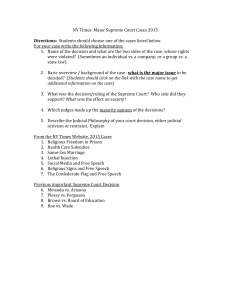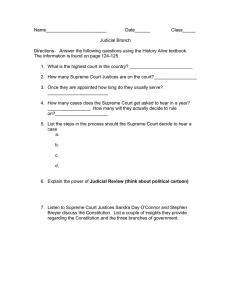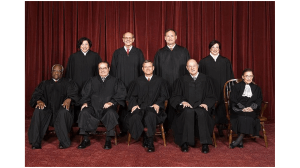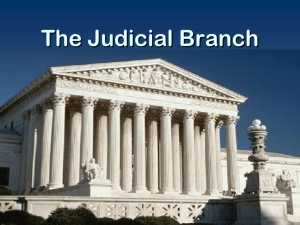Judicial Branch
advertisement
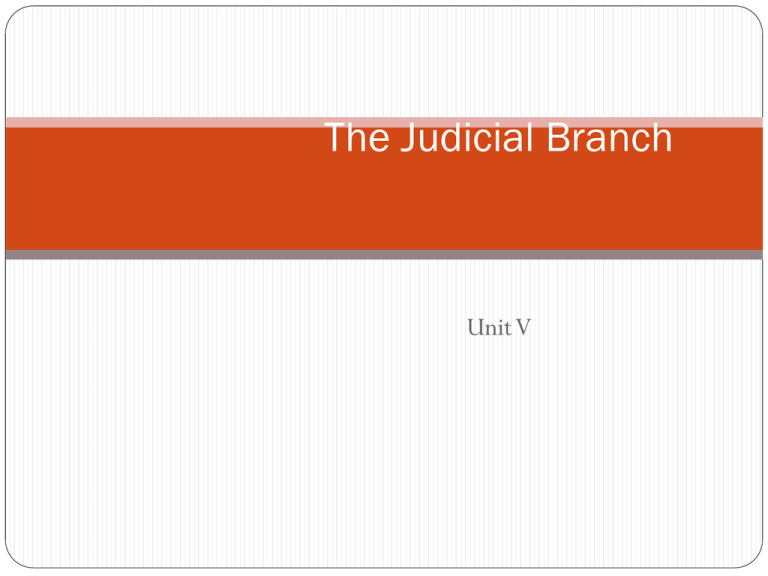
The Judicial Branch Unit V Essential Questions 1. 2. 3. Why is the Federal Judiciary set up the way that it is? How has/does the Judicial Branch affect(ed) American society? What does it mean that we enjoy “relative” rather than “absolute” rights? Outline 1) Judicial Review 2) Structure 3) The Supreme Court A) Process B) Landmark Cases C) Freedom of Speech 4) Putting it all together Found In: Article III in the Constitution Chapters 18-21 in your textbook Discussion Question “WE ARE A NATION OF LAWS” What are the implications of this statement? What does this mean? The Judicial Branch Article III Section 1. The Judicial Power of the United States,shall be vested in one supreme Court, and in such inferior courts as the Congress may from time to time ordain and establish. The Constitution creates only the Supreme Court of the United States. It gives the Congress the power to establish other lower, federal courts. Article III The Judges, both of the supreme and inferior Courts, shall hold their Offices during good Behavior, and shall, at stated Times, receive for their Services, a Comprehension, which shall not be diminished during their Continuance in Office. “…during good Behavior” a.k.a. life Role of the courts in American government Make policy Can undo work of representative institutions Judicial Activism or Judicial Restraint? Constitutional advocates? Bush v. Gore Citizens United v. FEC Power on federal courts U.S. Constitution Articles I-VII Amendments 1-10 aka Bill of Rights Amendments 11-27 Marbury v. Madison Judicial review Checks and Balances Defendant Arrested Trial Court Not Guilty Guilty can appeal to Defendant Free Court of Appeals Reverse Conviction Defendant Free Defendant Free Uphold Conviction can appeal to Minnesota Supreme Court Reverse Conviction Uphold Conviction Dual Court System States Federal Judicial review of state laws Minnesota Court System Federal system 94 District Courts: Criminal and Civil cases 13 Appeals Courts Appellate Justices – Life terms (“Good behavior”) 1 Supreme Court Judicial Review Marbury v. Madison SCOTUS U.S. Supreme Court Supreme Court of the United States Ultimate court of appeals in the U.S. Does not deal with guilt or innocence U.S. Supreme Court Cases appealed from federal and state system Control of docket (5k-7k hear 100-150) Session (October - June) Justices - 9 (life, appointed by president, confirmed by senate) Supreme Court (continued) Control over docket (rule of four) Solicitor general Amicus curiae brief Grant review Oral arguments Conference Judgment Chief Justice Session Cases are heard with all the Justices sitting together in open court. Majority, Concurring, and Dissenting Opinions U.S. Supreme Court 2012-13 John G. Roberts, Jr. Chief Justice First among equals Gets to decide who write the majority opinion Nominated by George W Bush Reagan’s Nominees Antonin Scalia Anthony Kennedy HW Bush’s Nominees Clarence Thomas Clinton’s Nominees Ruth Bader Ginsberg Stephen Breyer W Bush’s Nominees Samuel Alito Obama’s Nominees Sonia Sotomayer Elena Kagan Justices of the Supreme Court Nine Justices led by a Chief Justice of the Supreme Court. His/her main duty is administrational and ceremonial. For example? Nomination and confirmation can sometimes become very “political” Conservative, Moderate, Liberal Republican to Republican appointees Democrat to Democrat appointees Almost always…Why? U.S. Supreme Court 2012 The Roberts Court, 2012 Back row (left to right): Sonia Sotomayor, Stephen G. Breyer, Samuel A. Alito, and Elena Kagan. Front row (left to right): Clarence Thomas, Antonin Scalia, Chief Justice John G. Roberts, Anthony Kennedy, and Ruth Bader Ginsburg The Judicial Branch Unit V
